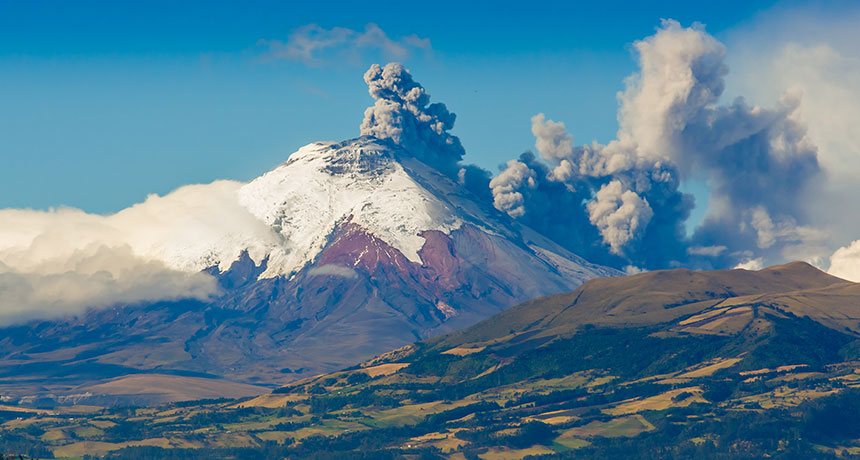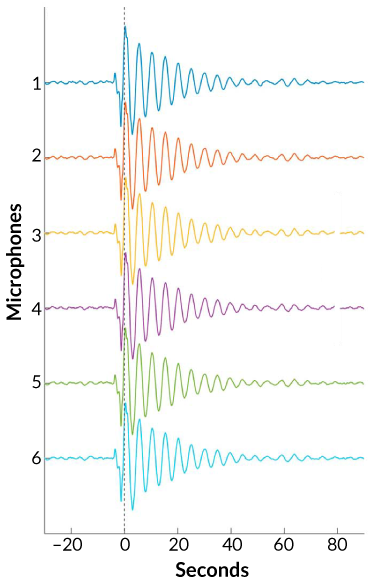This volcano revealed its unique ‘voice’ after an eruption
After a strong eruption in 2015, Ecuador’s Cotopaxi ‘rang like a bell’

SINGING VOLCANO For several months after Ecuador’s Cotopaxi volcano erupted in August 2015, scientists recorded odd patterns of reverberating sound.
Fotos593/Shutterstock
Ecuador’s Cotopaxi volcano has a deep and distinct voice. Between late 2015 and early 2016, Cotopaxi repeated an unusual pattern of low-frequency sounds that researchers now say is linked to the unique geometry of the interior of its crater. Identifying the distinct “voiceprint” of various volcanoes could help scientists better anticipate changes within the craters, including those that foretell an eruption.
Ecuadoran scientists installed a network of specialized microphones on the volcano’s flanks that can record very low frequency sounds, or infrasound. Two weeks after the volcano’s August 2015 eruption, the network recorded the unusual sound pattern — a strong, clear oscillation that tapers off through time. The sound curve resembles a screw, or “tornillo” in Spanish, scientists report online June 13 in Geophysical Research Letters.
Cotopaxi repeated this tornillo pattern 37 times between September 2015 and April 2016. Each time, the signal lasted through a dozen or more oscillations, resonating much like a musical instrument, before dying away. “[Cotopaxi] rang like a bell for more than a minute,” says geophysicist Jeffrey Johnson at Boise State University in Idaho, who led the study.
Infrasound waves have frequencies between about 0.01 hertz and 20 Hz — too low for humans to hear but audible to some animals including elephants (SN: 9/8/12, p. 11). Scientists have been eavesdropping on volcanoes for about two decades, with technology developed for the 1996 Comprehensive Nuclear Test-Ban Treaty’s infrasound monitoring network (SN: 8/5/17, p. 18).
Scientists are now using infrasound to study everything from volcano eruption dynamics to the movement of volcano-induced mudflows called lahars, Johnson says. “If you didn’t have infrasonic sensors, you wouldn’t pick up any of this. You would be deaf to this world of unique and beautiful sounds.”
Cotopaxi’s voice is unusually deep among recorded volcanos — a baritone among tenors. Resonating at around 0.2 Hz, its sounds were five times lower in frequency than those if many other volcanoes. Johnson and his colleagues attribute this strange voiceprint to air sloshing back and forth within the volcano’s deep, cylindrical crater.
What triggered the sound oscillation after the initial 2015 eruption is difficult to determine. Based on video from a nearby webcam, Johnson believes it was probably the intermittent release of gases from the magma lake within the crater.
Johnson suggests that other volcanoes may have similarly unique voices — even if they don’t speak in screw-shaped sound bites. Monitoring organizations could identify the “voiceprints” of the most worrisome volcanoes, and listen for sudden changes that might provide an early warning sign of volcanic unrest. For example, a volcano’s voice may change due to the rise or fall of a magma lake within the crater, he says. “Infrasound can tell us what’s happening at the surface [of an active volcano] when we can’t walk up to the crater and peer inside.”
The observation of tornillos in volcano infrasound recordings is “a very cool thing,” says Jonathan Lees, a seismologist and volcanologist at the University of North Carolina at Chapel Hill who was not involved in the new study. But it takes a very specific internal geometry to create such a sound — one not likely to be found at many other volcanoes, he says.
In searching for another bell-like crater, Johnson and his colleagues also listened to infrasound recorded at Congo’s Mount Nyiragongo volcano. “We did detect a low-frequency infrasound tone,” he says, but the sounds didn’t oscillate for a long time to create a tornillo. That is probably due to the width of Nyiragongo’s crater: At 3 kilometers across, it is more bowl-shaped than pipe-shaped, making it difficult to excite into ringing, long-lasting resonance.








